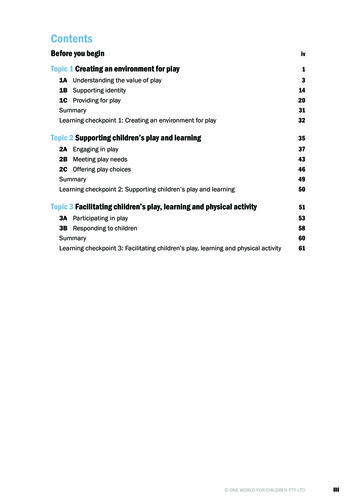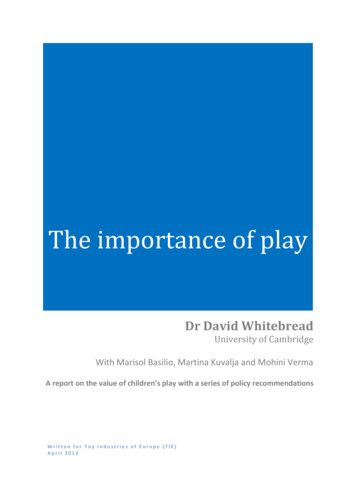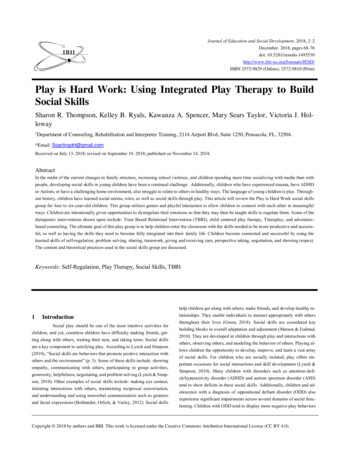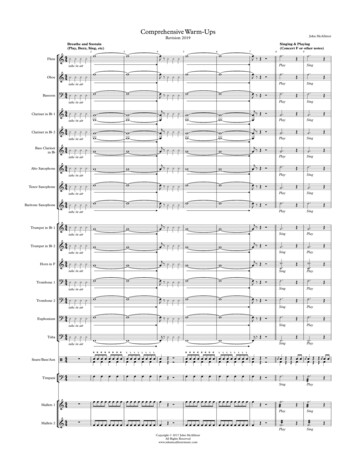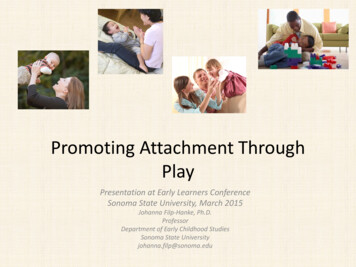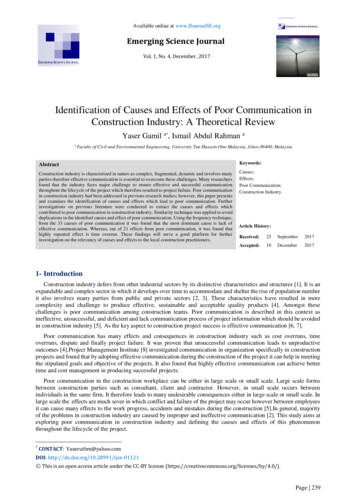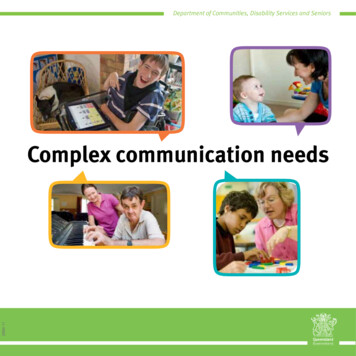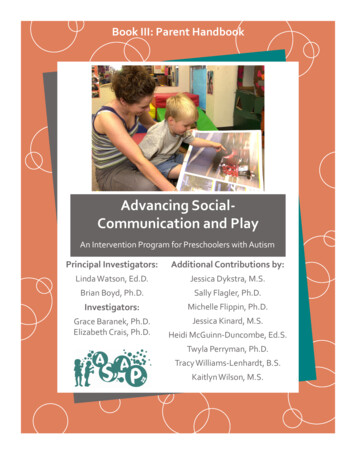
Transcription
Book III: Parent HandbookAdvancing SocialCommunication and PlayAn Intervention Program for Preschoolers with AutismPrincipal Investigators:Additional Contributions by:Linda Watson, Ed.D.Jessica Dykstra, M.S.Brian Boyd, Ph.D.Sally Flagler, Ph.D.Investigators:Michelle Flippin, Ph.D.Grace Baranek, Ph.D.Elizabeth Crais, Ph.D.Jessica Kinard, M.S.Heidi McGuinn-Duncombe, Ed.S.Twyla Perryman, Ph.D.Tracy Williams-Lenhardt, B.S.Kaitlyn Wilson, M.S.
AdvancingSocial-Communication & Play:An Intervention Program for Preschoolers with AutismBOOK III:PARENT HANDBOOKPrincipal Investigators:Linda Watson, Ed.D.Brian Boyd, Ph.D.Investigators:Grace Baranek, Ph.D.Elizabeth Crais, Ph.D.Additional Contributions By:Jessica Dykstra, M.S.Sally Flagler, Ph.D.Michelle Flippin, Ph.D.Jessica Kinard, M.S.Heidi McGuinn Duncombe, Ed.S.Twyla Perryman, Ph.D.Tracy Williams Lenhardt, B.S.Kaitlyn Wilson, M.S.ASAP ProjectUniversity of North Carolina at Chapel HillCampus Box #7122 Chapel Hill, NC 27599ASAP@unc.edu 2011 University of North Carolina at Chapel Hill. All rights reserved.
contentsiiAcknowledgements1SECTION 1: For ParentsAdvancing Social-Communication and Play: Parent GuideGoal and Activity Sharing Form from Teachers and Therapists to ParentsGoal and Activity Sharing Form from Parents to Teachers and Therapists12122Parent Handouts for Individual Social-Communication GoalsSocial Interaction GoalsRequesting GoalsJoint Attention Goals23232937Parent Handouts for Individual Play GoalsExploratory Play GoalsRelational Play GoalsFunctional Play GoalsSymbolic Play Goals4646505358i
acknowledgementsTHANK YOUto the many people who participated and contributedto make this project possibleFocusGroupParticipantsFrank Porter GrahamChild DevelopmentInstituteWake County PublicSchoolsJohn CotterKathy DavisMary JenneDon TrullPreschool teachersChildren & familiesPreschool teachers,teaching assistants, &therapistsChildren & familiesUniversity of NorthCarolina at Chapel HillKathleen BerrySpeech-language pathologygraduate studentsGraduate student assessorsTherapist &Teacher ManualReviewersThe research reported here was supported by the Institute of Education Sciences, U.S. Department ofEducation, through Grant R324B070056 to UNCUNC-ChapelChapel Hill. The opinions expressed are those of theauthors and do not represent views of the Institute or the U.S. Department of Education.ii
AdvancingSocial-CommunicationCommunication & Play:PlayAn Intervention Program for Preschoolers with AutismParent Guide1
Hello Parent,Welcome to the ASAP intervention program. The ASAPprogram targets two important skills for children with autism:social-communication and play.During the intervention, you will be provided with parentguide sheets to help you work on the key skills with your child athome. The parent guide sheets will help you know more aboutsocial-communication, play, and social interaction and why theyare important for your child’s development. The guide sheets willalso give you a better understanding of the goals we are workingon with your child at school.We realize that as a parent, your time is limited and yourschedule is likely very busy. We want to emphasize that doingthese activities at home can and should be fun for you and yourchild. It is a good idea to work with your child for short periods oftime at first and we hope you will look for ways to use theseteaching ideas in your daily routines. The most important point isthat both you and your child have fun doing the activities. Theactivities described here are intended as a guide to help you getstarted. Please feel free to adapt them to fit your child and yourschedule.2
SOCIAL-COMMUNICATIONWhat is social-communication?Social-communication refers to the way we use eye contact, gestures andlanguage to “tune in” to each other. These behaviors include SocialInteraction, or one-on-one (parent-child) engagement, Requesting, andJoint Attention, or the 3-point coordination of attention between child,parent, and some other object or event in the immediate environment.Each of these aspects of joint attention will be explained in the followingsections.Social-CommunicationSocial InteractionEarly one-to-oneengagement(parent-child)Requesting3Joint Attention3-point attention(parent-object-child)
What does social-communication look like?A child may indicate s/he wants snack by reaching for a box of crackerson the kitchen counter and then looking between you and the box ofcrackers. Children use eye gaze and gestures to establish socialcommunication by doing the G-R-A-S-P4
Why is social-communication important?Social-communication is a foundational skill for communicativedevelopment. Through social-communication, children learn what theirparents are paying attention to and talking about. Social-communication isalso the way children learn how to act on the world by drawing attentionto their needs and requests, even before the onset of language. Earlysocial-communication ability is related to later language development.Research has shown that for children with autism, social-communicationability may be delayed in its development.How do I help my child develop social-communication?In the following sections, we will talk about each of the components ofsocial-communication, what they look like, why they are important andhow to work on them with your child. The social-communicationcomponents we discuss are:Social InteractionRequestingJoint Attention5
SOCIAL INTERACTIONWhat is Social Interaction?Social interaction describes the verbal and nonverbal face-to-face exchangesbetween your child and you. Making sounds back-and-forth, singing, ticklegames, dancing games, and lifting up and down routines are examples of socialinteraction.Why is social interaction important?Social interaction is an important building block for social-communication andother communication skills. As your child learns to exchange vocalizations,looking, and movements with you, s/he is learning the back-and-forth socialskills that form the basis of language development.How can you work on social interaction?All types of back-and-forth games provide opportunities for you to work onsocial interaction with your child. For example, you can imitate the soundsyour child makes and see if s/he will repeat what has been said again and thustake another turn. Tickle games are also a fun way to work on socialinteraction. After your child learns the routine of a tickle game and starts toanticipate that you will tickle, try pausing and waiting to see if your child looksat you or touches your hand to get you to start tickling again. You can usesimilar pauses when singing familiar songs, counting or saying the alphabet.6
REQUESTINGWhat is Requesting?Requesting refers to the way your child asks you to give him/hersomething (e.g., juice) or to do some action (e.g., fix a toy car).Why is requesting important?Requesting also is a building block to developing social-communication.As your child learns to request, s/he becomes more successful in gettinghis/her needs met and realizing s/he has to interact with others to get thoseneeds met. Also, in making requests, your child learns to direct yourattention to the objects that s/he wants or to the things that s/he wants youto do for him/her.How can you work on your child’s requesting?Visual strategies are often helpful in teaching your child to request. Startwith items (e.g., crackers, a toy) you know your child really likes. Haveyour child exchange a photo of crackers to get a cracker. Also, offering achild a choice of two items provides a natural opportunity for your child tomake a request. For example, you can hold crackers in one hand andcookies in another and have your child indicate which one s/he wants bylooking at or reaching for the item. When s/he shows you what s/he wants,use that as an opportunity to pair the request with a verbal model7
(e.g., “Oh, you want crackers!”). Placing a favorite toy or snack your childenjoys into a clear plastic jar or container with a closed lid is another waysto elicit a request from your child. Hand the container to your child andsee if your child will use a vocalization, word or gesture (e.g., hand thecontainer back to you) to request help to get the snack or toy. Another ideais to use toys with a “stop” button or off-switch to help your child learn torequest. Turn the toy on, let your child engage with it and then turn it offand wait for your child to signal that s/he wants the toy back on.Please keep in mind that it is important that these requesting opportunitiesbe natural and enjoyable for both you and your child. If your childshows you what s/he wants by looking, reaching, or pointing, you canmodel the request for him/her (e.g., “Oh, you want more Cheerios”) andgive him/her the item. In this way, you are teaching your child to makerequests, without making this a stressful situation.8
JOINT ATTENTIONWhat is Joint Attention?Joint attention refers to the way we use eye contact, gestures and languageto “tune in” to each other. Joint attention refers to the specific ability of achild to (1) attend to an object or event, (2)“check in with you,” and (3)attend back-and-forth between you and the object or event. In jointattention episodes, your child is not checking in to make a request or to getsomething s/he wants but is looking between you and an object or event,just to share in the moment or activity.Is joint attention the same as paying attention?Not exactly. When we say a child is “paying attention” that can have avariety of meanings. It may mean s/he is listening to us and our words.However, it can also mean s/he is looking at a particular toy or T.V. show.Some children can be very attentive to preferred topics or particular toys,T.V. shows or computer games and yet have very poor joint attention.When we say a child is showing joint attention, we mean that s/he isengaging in the very important social skill of “tuning in” to another personto share experiences or to make requests. Joint attention requires a backand-forth interaction (verbal and/or nonverbal) and shared attentionbetween child, parent and some other object or event in the immediateenvironment.9
Child looks attrainMom looksat trainChild looksback at MomWhy is joint attention important?Joint attention is a foundational skill for the development of language andsocial-communication. Through giving, reaching, attending, showing andpointing (G-R-A-S-P), your child is learning to draw your attention tosomething s/he is enjoying or to follow your gestures or vocalizations tofind out what you are showing him/her.How can you work on your child’s joint attention?When your child reaches toward, points at, shows you, or gives you anobject, look at the object and at your child, then comment about that objector name it. For example, if your child points to a dog, look back-and-forthbetween your child and the dog and comment about the dog (e.g., “Look,big dog!”). You can also work on joint attention by pointing, showing, orgiving an object of interest to your child while looking at and talking toyour child. Book sharing is another way to take turns pointing outinteresting pictures and story events with your child. Finally, you cancreate fun opportunities for your child to share with you by hidingmotivating toys under boxes or other coverings and letting your child findit and show it to you.10
PLAYWhy is play important?Play refers to how children explore toys, put toys together, and begin touse imagination to act out roles and pretend. Play is a foundational skillfor social and language development. Children learn through play. Playskills provide children with common interests they can talk about with anadult or peer. Research has shown that children who engage in pretendplay will have more opportunities to successfully interact with peers andthus increase their own social skills.For children with autism, intervention that improves play skills has alsobeen shown to improve language skills. Thus, targeting play skills isparticularly important for our children with autism who have difficultylearning how to play. Children with autism often learn some aspects ofplay (e.g., lining up cars; enacting parts of favorite T.V. shows).However, they may need support to attain a full-range of play skills and tobe able to use those skills in a variety of situations.11
How do play skills develop?Children’s play develops over 4 increasingly complex stages. Generally,these four different types of play are categorized in the following areas:Symbolic PlayFunctional PlayRelational PlayExploratory PlayIn the following sections, we will discuss each of these 4 levels of play,explaining each level and providing ideas for targeting these play skillswith your child.12
EXPLORATORY PLAYWhat is Exploratory Play?In exploratory play, children are examining and learning about theproperties of toys through mouthing, banging, spinning, dropping,pushing, etc.How can you work on your child’s exploratory play?Join in your child’s exploratory play by rolling balls or modeling how toturn pages in a book or blow bubbles. Your child may need modeling andsupport to investigate new textures or toys. Provide a variety of differenttypes of toys that make different sounds and have different textures andedges. Shiny toys can be very enticing, as can toys that have movementand noise. Provide opportunities for humor and surprise with the toys.Once your child has shown some interest in exploring toys, you can beginteaching him/her how to start using 2 or more toys together in meaningfulways.Recommended toys:Balls, slinky, play-dough, bubbles, mechanical toys13
RELATIONAL PLAYWhat is Relational Play?At this stage, your child starts to put objects together in his/her play.Examples of this kind of play are putting together puzzles, stackingblocks, removing and replacing lids on pots, lining up toys, or sorting(e.g., shapes, colors, or animals by category).How can you work on relational play with your child?You can model relational play for your child by constructing a block towerand knocking it down, putting objects together (e.g., stringing beads), andsorting shapes in a shape sorter.Recommended toys:Blocks, shape sorters, puzzles, toy pots and pans with lids14
FUNCTIONAL PLAYWhat is Functional Play?Functional play is how children first learn to pretend. In this stage of play,children start to move beyond understanding how to use 2 toys together (e.g.,stacking toys, putting toys in and out, placing a spoon in a toy cup) to somebeginning pretend play with the toys (e.g., stirring the spoon in the cup,pretending to drink from a toy cup). Functional play involves using toys in theway they are meant to be used. Using toy phones to call someone and cookingwith miniature pots and pans are examples of functional play.How can you work on functional play with your child?You can have fun modeling these early pretend skills for your child. Forexample, pretend to drink from a cup. Exaggerate sipping sounds and say“ahh” when you are finished sipping. When your child is able to imitate yourpretend models, you can begin to add in more elements to the play over time.For example, you can pretend to eat with a spoon. You can also let your childfeed you from a spoon or model for your child feeding a doll or toy animal.Recommended Toys:Dolls (including “action figures”), stuffed toys, toy plates, cups, spoons forpretend eating, housekeeping sets15
SYMBOLIC PLAYWhat is Symbolic Play?Symbolic play refers to a high level of pretending that includessubstituting one object for another (e.g., pretending a block is a car),pretending something has a property it does not have (e.g., pretending toyFrench fries are hot), or referring to something as if it were present (e.g.,pretending there is tea in a toy teapot). Finally, role play, when a childpretends to be a teacher or firefighter, is another form of symbolic play.How can you work on symbolic play with your child?Pretend cooking activities are a great way to pretend with your child that afood is too hot or too cold or for substituting one object for another (e.g., ablock for milk). You can substitute one object for another by suchactivities as pretending two chairs positioned side by side are the frontseats of a car or the seats of an airplane, or that a large box is a house, afort, or a cave. Role-playing games are another way to target symbolicplay skills. For example, you can have your child act out a role from afavorite game or video. When your child is able to take one role, you canthen increase the complexity by trading roles with your child (e.g., haveyour child play the ‘bad’ monster instead of the ‘good’ monster). Roleplay is also a good opportunity to model problem-solving skills.16
For example, you and your child can talk about how to make a ‘mean’alligator into a ‘nice’ one (i.e., what could the alligator do to change?).Don’t be afraid to have fun and be silly with your child during symbolicplay. For example, changing your voice when you read or putting on a hator funny nose can help a young child learn and practice humor.Recommended Toys:Toy plates, cups, spoons, dolls, dress up clothes, materials for forts, aplayhouse, tool chest, books17
Prompting Your Child’s SuccessPrompts are a way of providing support to your child’s learning and are a useful tool in teachinga new skill. When your child is learning a new skill, s/he may require help in the beginning, butas s/he begins to show progress, you will want to provide less help so that s/he can eventuallyuse the skill independently. Below is a chart showing the prompt levels from the “LeastDirective” up through the “Most Directive.” Be sure to give your child time to respond bywaiting before moving on to the next prompt.Type of PromptMostDirectivePhysicalAssistance(Partialor Full)Modeling(Partialor Full)SpokenInstructionsSpoken lLeastDirectiveDescriptionExampleGuide your child’s arm oruse "hand-over-hand."When teaching your child to roll play-dough,guide their hand to the play-dough by theirelbow OR take your child’s hand into yourhand and guide him/her to roll the play-doughif they need additional support.Model the targeted skill foryour child partially or fully,showing them exactly whatyou want them to do.When teaching your child to throw a ballthrough a hoop, you can hold the ball up as ifyou are about to throw it into the hoop andWAIT to see if s/he will throw his/her balltowards the hoop OR you can throw your ballinto the hoop and give a ball to him/her to seeif s/he will imitate you.When teaching your child to pretend to washa stuffed dog, say, “Give the dog a bath.”Tell your child (in simplelanguage) exactly what youwant them to do.Give your child a hint aboutwhat you want the child todo.If you want your child to pretend to give youa drink from a toy cup the child is playingwith, say, “I’m thirsty!”Use a point or other gestureto prompt the expectedresponse.Point or reach towards a toy that you wantyour child to give you or point towards theroad map that you want him/her to his/her toycar on.When teaching the child to put toys together,place the next size nesting cup or puzzle piececlosest to the child.Position the correctresponse in a particularlocation, so that the child ismore likely choose it.Set up the space toencourage your child towork on a specific skill oruse a picture(s) or other twodimensional representation(words, symbols, etc.) thatillustrates the skill.18Remove extra toys and leave only the itemsyou want your child to use accessible to themOR have a picture sequence, such as a pictureof the toy bus, a picture of the toy people, anda picture of the toy people in the bus.
Here is an example of how you would run through the prompt levels when teaching a newskill, beginning with the least directive prompt (e.g., environmental or positional) andworking up to the most directive prompt (physical assistance).If you are trying to teach your child to feed a baby doll or stuffed animal, you might:1) If you are seated at the table, have only the doll/animal, spoon, and bowl available at thetable. This would be an example of an environmental prompt. Or you could show your child apicture or picture sequence of someone feeding a doll. This would be a pictorial prompt.2) If your child does not respond, you may want to place the spoon near his/her hand. Thiswould be an example of a positional prompt.3) If the positional prompt is unsuccessful, you can use a gesture such as handing the spoon tohim/her or pointing to the spoon.4) Next you can offer a spoken hint such as, “The baby is hungry”5) You can then offer direct spoken instructions by telling him/her, “Feed the baby”6) Your next step would be to feed the doll yourself to model what you want him/her to do andwatch to see if s/he will imitate.7) If lower level prompts have not been successful, you can move to physical assistance byplacing the spoon in your child’s hand and pushing his/her elbow to move his/her arm towardsthe doll (partial physical assist) OR place your hand over his/her hand that is holding thespoon and guide it to the dolls mouth (full physical assist).Be sure to keep the activity fun for your child! As you are feeding the doll, make sounds andsay something like, “Yum, yum! The baby likes the food. She was so hungry.”Being silly and making sounds can help to keep your child engaged and will encourage him/herto imitate what you are doing. Also, remember to give your child enough time betweenprompts. Wait and watch to see what s/he can do!19
Goal and Activity Sharing Forms to BuildCollaboration BetweenParents and School Staff20
Goal and Activity Sharing Formfrom School Staff to ParentsDate:Dear ,This week, we are working on the following social-communication andplay goals with .Social-Communication Goal:Here are some activities we are trying with your child in the classroomto target this goal:Here are some suggestions for you to try in targeting this goal at home:Play Goal:Here are some activities we are trying with your child in the classroomto target this goal:Here are some suggestions for you to target this goal at home:21
Goal and Activity Sharing Formfrom Parents to School StaffDate:Dear ,This week, we are working on the following social-communication andplay goals at home with .Social-Communication Goal:Here are some activities we have found to be effective in targeting thisgoal at home:Here are some things we are struggling with or would like moreinformation on:Play Goal:Here are some activities we have found to be effective in targeting thisgoal at home:Here are some things we are struggling with or would like moreinformation on:22
Social Interaction GoalsSocial interaction describes the back-and-forth exchanges between you and your child. Whenyou engage in these face-to-face games, your child is learning to communicate.Social Interaction Goal 1. During face-to-face games, physical activities, or routines, yourchild watches you closelyThe purpose of this goal is to help your child interact with you more often and moreconsistently. It will also teach your child that when s/he looks at you and shows interest in afun game or routine, you will continue to play the game or routine with him/her. Play any ofthe games listed below with your child (or similar games that you and your child enjoy). In themiddle of the game, pause to see if your child will look at you. If your child doesn’t look, wait afew seconds before doing the action again. The idea is to get your child to show you s/he wantsto keep going by looking at you. Even if your child doesn’t look, keep doing the action andwaiting in between actions to try to get him/her to look. Continue to play the game as long asyour child is interested. If your child does not seem interested in a certain game or does not likeit, try another game.Suggested activities: Peek-a-booTicklingPushing child on a swingItsy Bitsy SpiderRing-around-the-RosieLifting child over your headNotes/Suggestions:23
Social Interaction GoalsSocial interaction describes the back-and-forth exchanges between you and your child. Whenyou engage in these face-to-face games, your child is learning to communicate.Social Interaction Goal 2. During face-to-face games, physical activities, or routines, aftera brief pause your child shows wanting the game to continueThe purpose of this goal is to help your child learn to look at you and say a sound or word(s), ormake a gesture to let you know that s/he would like you to keep a fun game or routine going.For example, after bouncing your child on your lap and stopping, s/he bounces to show you todo it again. Or after you take a turn in peek-a-boo, your child pushes the blanket toward you (orpulls on your arm) to do it again.Suggested activities: Use activities similar to those used in Social Interaction 1 (e.g., peek-a-boo, tickling,pushing child on a swing, Itsy Bitsy Spider, Ring-around-the-Rosie, lifting child overyour head), but pause in the middle of the activity before continuing to encourage yourchild to look at you, vocalize, use a word, or gesture. Play Ring-around-the-Rosie two times. Once you know that your child is having fun andengaged in the game, start the song and movement a third time, but stop in the middle ofthe song and pause for several seconds. As soon as your child looks at you, speaks, orgestures, finish the song and movement. If your child does not look at you, speak, orgesture, provide a prompt such as, “Hey!” (to get your child to look at you) or “Do youwant to play more?” or placing your hands in a position to play the game and wait to seeif your child will touch or move your hands.Notes/Suggestions:24
Social Interaction GoalsSocial interaction describes the back-and-forth exchanges between you and your child. Whenyou engage in these face-to-face games, your child is learning to communicate.Social Interaction Goal 3. Your child plays back-and-forth games with objects or actionsThis goal will help your child engage with you through sharing objects and copying actions.You can use just about any activity or toy that your child likes to try to encourage back-andforth exchanges of objects and imitation. The main idea is to get your child to take turns withyou playing with objects or in imitation.Suggested activities: During bath time, push a boat over to your child then encourage your child to push theboat back to you. Make fun motor noises and make waves for the boat. You can also useother bath toys like animals or bath crayons to take turns and encourage your child toimitate your actions. Take turns making faces in a mirror that is large enough for both of your faces. Stick outyour tongue and wait to see if your child will also stick out his/her tongue. Put yourthumb on your nose and wiggle your fingers. Wait to see if your child imitates you. Putyour thumbs in your ears and wiggle your fingers. Wait to see if your child repeats afteryou. Suck in your cheeks and make fish lips, and see if your child will do the same thing.Any kinds of actions, sounds, or gestures will do. Toss a ball or bean bag to your child from 1-2 feet away. Encourage your child to throwthe ball or bean bag back to you. Continue to toss the ball or bean bag back-and-forth forseveral minutes. Sometimes having another child or person join the game may help yourchild see how to do it.Notes/Suggestions:25
Social Interaction GoalsSocial interaction describes the back-and-forth exchanges between you and your child. Whenyou engage in these face-to-face games, your child is learning to communicate.Social Interaction Goal 4. Your child initiates familiar games or routinesThe purpose of this goal is to encourage your child to show you that s/he wants you to play afamiliar game with him/her. You can play games like those used in Social Interaction 1, suchas tickle and peek-a-boo. For example, first play peek-a-boo using a blanket to cover your headand your child’s head. After several turns covering your head and covering your child’s head,put the blanket next to you on the floor or sofa and start a tickle game. After a few moments ofplaying the tickle game, stop tickling your child and pause to see if s/he will pick up the blanketto initiate the peek-a-boo game. Sometimes having another child or person pick up the blanketand start the game with you may help your child see how to do it.Suggested activities: Peek-a-boo and tickling game Swinging and Ring-around-the-Rosie Playing with cars and building with blocksNotes/Suggestions:26
Social Interaction GoalsSocial interaction describes the back-and-forth exchanges between you and your child. Whenyou engage in these face-to-face games, your child is learning to communicate.Social Interaction Goal 5. Your child expands games or routinesThe activities for this goal will help your child interact socially in more varied ways, that meansyour child will learn to play a variety of games and activities with several different people (e.g.,you, your spouse, siblings, grandparents). For example, it is important that your child is able toplay social games with you and also with other family members and peers. To target this goal,you will need to enlist the help of others in your family including your partner, other children,and grandparents. Your child should also be able to take part in games in different ways—forexample, be able to start a game as well as to join in a game that you start, or be able to chaseyou as well as to run when you chase him/her.Suggested activities: Ring-around-the-Rosie: Begin a game of Ring-around-the-Rosie then have anotherperson join in the song and dance. Or, if you are the one who usually starts the song anddance, wa
i Acknowledgements ii SECTION 1: For Parents 1 Advancing Social-Communication and Play: Parent Guide 1 Goal and Activity Sharing Form from Teachers and Therapists to Parents 21 Goal and Activity Sharing Form from Parents to Teachers and Therapists 22 Parent Handouts for Individual Social-Communication Goals 23
